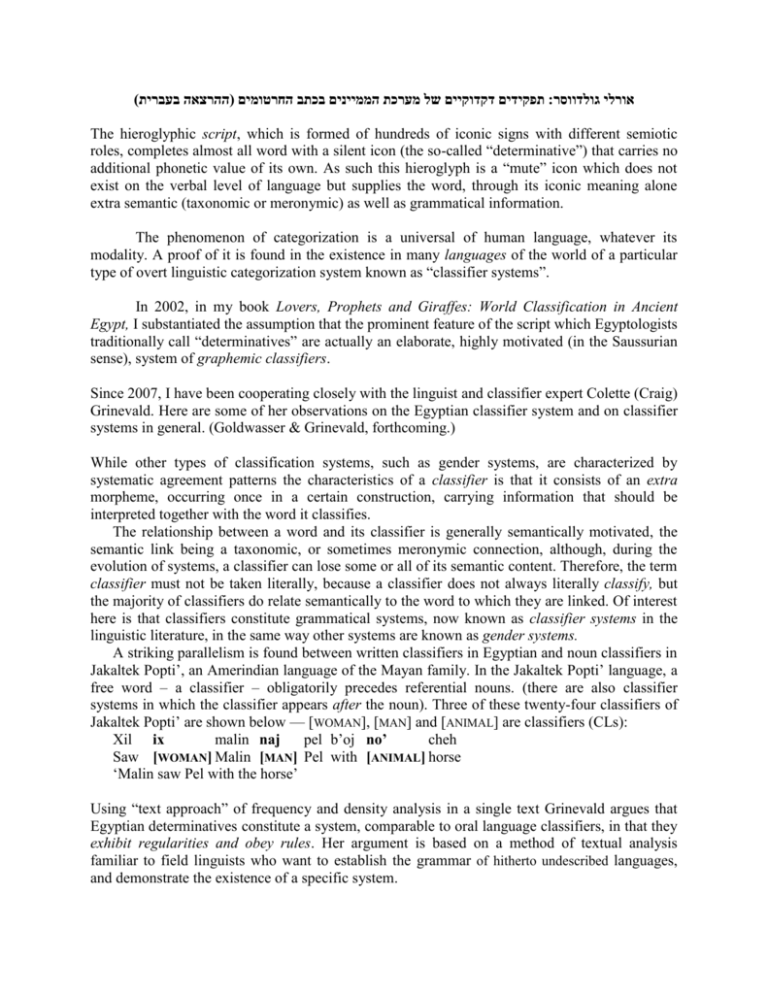אורלי גולדווסר: תפקידים דקדוקיים של מערכת הממיינים בכתב החרטומים
advertisement

) תפקידים דקדוקיים של מערכת הממיינים בכתב החרטומים (ההרצאה בעברית:אורלי גולדווסר The hieroglyphic script, which is formed of hundreds of iconic signs with different semiotic roles, completes almost all word with a silent icon (the so-called “determinative”) that carries no additional phonetic value of its own. As such this hieroglyph is a “mute” icon which does not exist on the verbal level of language but supplies the word, through its iconic meaning alone extra semantic (taxonomic or meronymic) as well as grammatical information. The phenomenon of categorization is a universal of human language, whatever its modality. A proof of it is found in the existence in many languages of the world of a particular type of overt linguistic categorization system known as “classifier systems”. In 2002, in my book Lovers, Prophets and Giraffes: World Classification in Ancient Egypt, I substantiated the assumption that the prominent feature of the script which Egyptologists traditionally call “determinatives” are actually an elaborate, highly motivated (in the Saussurian sense), system of graphemic classifiers. Since 2007, I have been cooperating closely with the linguist and classifier expert Colette (Craig) Grinevald. Here are some of her observations on the Egyptian classifier system and on classifier systems in general. (Goldwasser & Grinevald, forthcoming.) While other types of classification systems, such as gender systems, are characterized by systematic agreement patterns the characteristics of a classifier is that it consists of an extra morpheme, occurring once in a certain construction, carrying information that should be interpreted together with the word it classifies. The relationship between a word and its classifier is generally semantically motivated, the semantic link being a taxonomic, or sometimes meronymic connection, although, during the evolution of systems, a classifier can lose some or all of its semantic content. Therefore, the term classifier must not be taken literally, because a classifier does not always literally classify, but the majority of classifiers do relate semantically to the word to which they are linked. Of interest here is that classifiers constitute grammatical systems, now known as classifier systems in the linguistic literature, in the same way other systems are known as gender systems. A striking parallelism is found between written classifiers in Egyptian and noun classifiers in Jakaltek Popti’, an Amerindian language of the Mayan family. In the Jakaltek Popti’ language, a free word – a classifier – obligatorily precedes referential nouns. (there are also classifier systems in which the classifier appears after the noun). Three of these twenty-four classifiers of Jakaltek Popti’ are shown below — [WOMAN], [MAN] and [ANIMAL] are classifiers (CLs): Xil ix malin naj pel b’oj no’ cheh Saw [WOMAN] Malin [MAN] Pel with [ANIMAL] horse ‘Malin saw Pel with the horse’ Using “text approach” of frequency and density analysis in a single text Grinevald argues that Egyptian determinatives constitute a system, comparable to oral language classifiers, in that they exhibit regularities and obey rules. Her argument is based on a method of textual analysis familiar to field linguists who want to establish the grammar of hitherto undescribed languages, and demonstrate the existence of a specific system. Once the fact that determinatives constitute a rule-governed system of classifiers is established, the systematic comparison of the Egyptian system with the well-known linguistic phenomenon of classifiers becomes very productive, revealing striking similarities between these “mute” graphemic determinatives and spoken classifier systems found in hundreds of languages from around the world. We argue that these are two modalities - spoken and written - of the same cognitive phenomenon. In recent years a third modality of classifiers is acknowledged by scholars, “signed” classifiers in sign languages. Within the Egyptian classifier system, we have identified three main domains of information: – The first domain of information is of an encyclopedic nature. If we consider that every lexeme is in reality a complex “knowledge frame”, and that each word evokes cultural prototypes, then the role of classifiers is to direct the reader to a more explicit referent, by providing a wide range of encyclopedic information about it. For instance, within the “noun universe,” the classifier may provide information such as gender, social status, animacy, material, or shape; and for verbs, the classifier may provide information about event schemata and the nature of its arguments. Culture-specific knowledge may also emerge through the classification system. – Another level of information, discourse-pragmatic in nature, stems from the fact that scribes often had choices between several classifiers and combinations of classifiers. These options are usually traditional alternatives for the word’s classifiers, but in rare cases we may find the introduction of a discourse-specific classifier. Thus, the selected classifiers provide additional information about specific referents at the time of discourse, such as who is talking, with regards to what specifically, and with what attitude or intention.1 – Finally, classifiers can provide grammatical information. For instance, they can indicate where a root or stem ends and where a suffix starts. Classifiers can also mark derivational processes, such as deriving a noun from a verb, or syntactic boundaries, such as the end of a relative clause. In this lecture I shall present some of the grammatical roles of the classifiers along with some discourse-pragmatic functions. Goldwasser O. & Grinevald C. What Are Determinatives Good For? in E. Grossman, S. Polis. & J. Winand (eds.), Lexical Semantics in Ancient Egyptian, Lingua Aegyptia Studia Monographica, Göttingen: Seminar für Ägyptologie und Koptologie. Further reading on classifiers in general (attached PDF) Grinevald, C. Making Sense of Nominal Classification System, in I. Wischer and G. Diewald (ed.), New Reflection on Grammaticalization. Amsterdam, Philadelphia: John Benjamins Publishing. pp. 259-275. PDF 1 E.g. The verb rx “to know” when referring to “knowing a woman” in the Biblical sense, may be written with the phallus classifier [instrument] (DZA 26.029.740 and 26.029.670).





